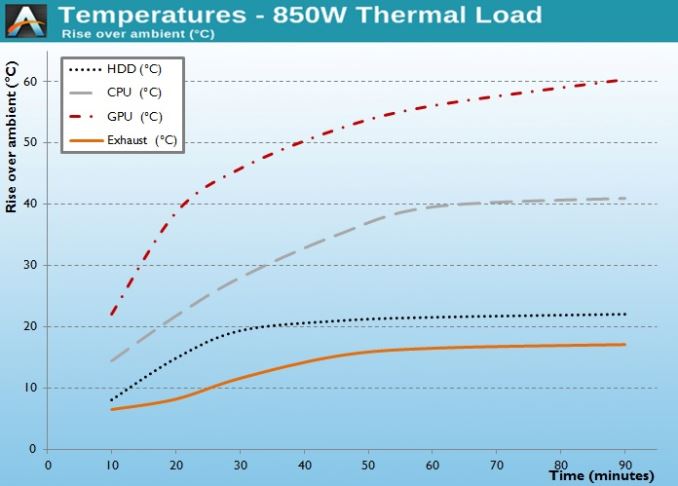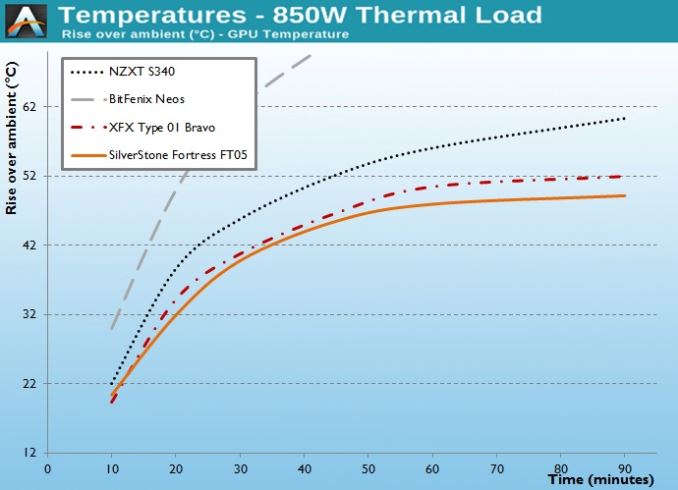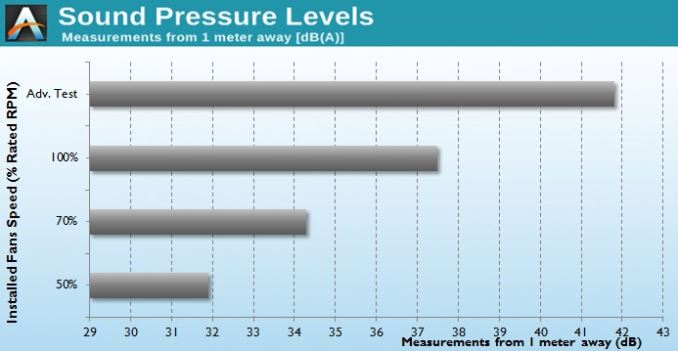The NZXT S340 Case Review
by E. Fylladitakis on July 13, 2015 8:00 AM EST- Posted in
- Cases/Cooling/PSUs
- NZXT
- Case
- ODD-Free
Test Setup
Professional testing requires the emulation of real-world situations but with repeatable results; thus, a perfectly controllable test setup and environment are required, especially for comparable results. Testing the thermal performance of any case with a typical real-world setup technically limits the comparability of the results to this setup alone, as an active system interacts with its environment and the change of a single component would alter myriads of variables. As such, we developed synthetic loads that emulate the thermal output of real systems, which however are passive, steady and quantifiable. As such, the thermal testing now displays the thermal capabilities of the case alone, as if it would have to deal with the entire thermal load by itself, regardless of the system that would be installed inside it. Laboratory data loggers are being used to monitor the PT100 sensors and control the safety relays, which are fully accessible via our custom software. Three such loads have been developed; the ATX version simulates a 200W CPU, 50W VRM, 30W RAM and 4 × 120W GPU card thermal load. Finally, three 3.5" HDD dummy loads have also been created, with each of them converting 30 W of electrical power to thermal, bringing the total thermal load of the ATX test setup up to 850 Watts. As such, the thermal load is immense and only the best of cases will be able to handle it for more than a few minutes, we are also performing a test with a thermal load of 400W, with all of the aforementioned components except the HDD drives at about 42% power, which is more suitable for the majority of cases.
Thermal testing has been performed with all of the case's stock fan operating at maximum speed. Noise testing has been performed with a background noise level of 30.4dB(A). Advanced noise testing is also being performed, in order to assess the ability of the case to dampen the noise of the components installed inside it. This includes the installation of two noise-generating sources (strong fans) inside the case, one positioned approximately over the first expansion slot and one over the CPU area, which generate ≈ 44.2 dB(A) when unobstructed. During the advanced noise test, all stock cooling options of the case are entirely disabled.
Results and Discussion
Considering the design and price range of the NZXT S340, we did not expect its thermal performance to be outstanding, and it is not. However, it is better than we originally anticipated. The small mid-ATX S340 does a lot better than a generic case design, such as the BitFenix Neos, despite its smaller volume. As for other similar designs, the SilverStone Fortress FT05 may not be a very fair comparison, as it does share an "ODD-Free" design and similar system area volume, but it is more than twice as expensive. Still, it is noteworthy to see how the dual Penetrator fans give the FT05 a significant performance edge over the conventional design of the S340. The weakest point of the S340 is, as we anticipated, the HDD area. Even though the lack of active cooling on our testing equipment should create ideal flow conditions, with the air coming in from the front of the case and exiting via the cooling fans, the temperatures in the HDD area were higher than usual.
The stock cooling fans of the NZXT S340 are not overly strong or loud, nor too weak. In our opinion, they are an ideal choice for a case of this price range that is designed for typical home and a gaming PC. At their maximum speed, the fans are audible, reaching 37.4 dB(A). The S340 has no fan controller but, assuming that the motherboard supports this function, the fans can be powered from motherboard headers and be automatically controlled via the BIOS settings, thus allowing the system to operate quietly while temperatures are low.
As expected, the S340 has low sound dampening capabilities. Even though there is a solid faceplate, the chassis beneath it is entirely open. Furthermore, there are several large openings at the back and a cooling fan at the top of the case, as well as more openings at the bottom of the case. Still, the S340 reduced the noise of our dummy test source from 44.2dB(A) to 41.8dB(A). The difference is small and probably not easily discernible, but it remains a quantifiable difference nevertheless.















48 Comments
View All Comments
Impulses - Monday, July 13, 2015 - link
People are so eager to ditch ODDs, might as well use USB hubs too instead of front ports! Just being facetious, I know the latter takes up little room, probably just a sacrifice in order to hit their price point.BrokenCrayons - Tuesday, July 14, 2015 - link
I'm not sure there's a good reason to push along the demise of optical media. Yes, very slow, takes a lot up a lot of space, and is losing relevance over time, but in a desktop system where space isn't typically a major concern there's not as much of a reason to abandon optical drives very quickly. Laptops, on the other hand, benefit from it because the space can be reclaimed to reduce the system's footprint, allocate space for more effective cooling, increase battery capacity or whatever else.Anyway, yes, it's probably a cost related matter that resulted in there being only a couple of USB ports and an external hub would solve the problem, though it'd be a sort of awkward solution to a problem that really shouldn't have existed in the first place.
Impulses - Tuesday, July 14, 2015 - link
Oh I agree, I still buy some movies AND music on disc and if I can have it in a bay I'd much rather have that than another external device cluttering my desk...There's already 3 displays, 2 amps (Emotiva for speakers, Asgard 2 for hp) and soon a DAC on my desk, and the external backup HDD occupies the sliver of space next to the case on the file cabinet it sits on.
I actually view half a dozen 3.5" bays (on other cases) as a larger waste of space than one or two 5.25" bays which can also be used for card readers, fan controllers, etc.
3.5" bays also tend to take up a sizeable chunk of internal space and they complicate thermals whereas a 5.25" bay can be designed in vertically or atop the entire rest of the chassis (without increasing it's volume outwards by more than the bay's thickness rather than a few 3.5" bays' length.
Dorek - Wednesday, July 29, 2015 - link
It's very rare that anyone needs to use more than two front-USB devices at once. I would say that situation has basically never happened to me.Steveymoo - Monday, July 13, 2015 - link
I thought I was seeing things for a minute there. ATI Radeon? Blast from the distant past!extide - Monday, July 13, 2015 - link
Yeah they look like Radeon 5800 series cards, I think.ES_Revenge - Monday, July 13, 2015 - link
Oh c'mon they're not *that* old. I'm guessing you also missed the mobo is P55--LGA1156? :P They probably just have "old" components lying around to do case reviews--it's not like you need a Haswell i7 in there and GTX 980 Tis, just to do a case review.I'm pretty sure I've seen this same components in other case reviews so they must be their go-to stuff for such reviews.
Dorek - Wednesday, July 29, 2015 - link
IMO they *should* be using new components and actually installing full systems in these cases, instead of this weird "fake computer load" thing this guy does. But everyone has mentioned this many times on the (somewhat useless) case reviews this guy does.jann5s - Monday, July 13, 2015 - link
why are there ATI radeons inside? feeling nostalgic?extide - Monday, July 13, 2015 - link
Older high end GPU's work great for testing clearances and cooling capabilities of cases. Performance doesnt matter but size and heat generation are similar to current cards. (Although the reviewer in this article uses simulated loads for thermal testing, not those GPU's)